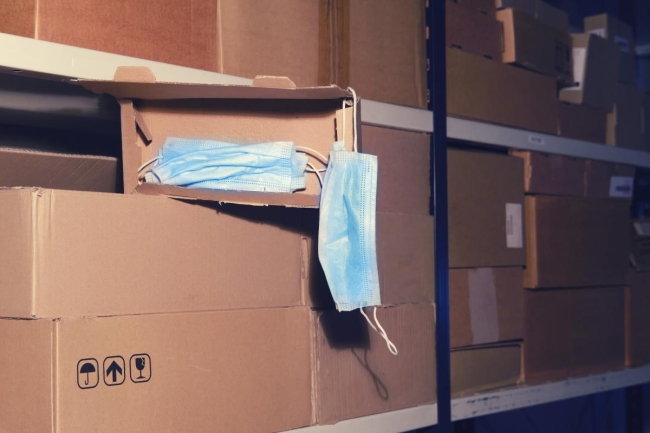You have /5 articles left.
Sign up for a free account or log in.

Some colleges can no longer require face coverings as states lift mask mandates.
Andrey Zhuravlev/iStock/Getty Images Plus
A string of states lifting indoor mask mandates means changes are in store for a number of public colleges in the U.S., though others will continue with face coverings for the foreseeable future.
Following a slowdown in the latest COVID-19 surge, a handful of states across the country have dropped mask mandates in recent days. Now states including California, Connecticut, Delaware, Nevada, New Jersey, New York and Oregon are changing their mask requirements—some effective are immediately, and others will be rolled out over time. However, some states will still require those working and studying in colleges and K-12 schools to continue to mask up as a COVID-19 precaution.
How State Rules Vary
Nevada dropped its mask mandate Thursday, citing falling coronavirus infections, though the governor announced that employers, organizations and school districts were free to craft their own requirements. The Nevada System of Higher Education (NSHE) quickly followed the state’s lead, announcing Thursday that it would no longer require face coverings, effective immediately.
In a message to campus, officials at the University of Nevada at Las Vegas announced that “masks are no longer a requirement on UNLV campuses except those areas where healthcare services are being provided.” Additionally, UNLV will continue to provide KN95 masks to those who want them, test unvaccinated employees weekly and encourage the use of face coverings.
Across the state at the University of Nevada at Reno, President Brian Sandoval shared a similar message with the campus, hitting the same themes but adding that NSHE decided that “employees who have received a religious or medical condition waiver” from the COVID-19 vaccination policy are “no longer required to wear a face covering as a condition of their waiver approval.”
California’s mask mandate expires this week, though regional masking may continue, since some counties adhere to COVID-19 protocols that are stricter than state rules. That’s the case in Los Angeles County, where the University of California, Los Angeles, will continue to require masks.
“Counties are authorized to keep stricter guidelines in place, if desired, and the L.A. County Department of Public Health (LACDPH) has opted to do so,” the UCLA COVID-19 Response and Recovery Task Force announced Friday. “UCLA cannot be less restrictive than LACDPH and therefore will continue with its universal indoor mask requirement until further notice.”
In New York, mask mandates are set to expire but will temporarily remain in educational settings.
“We know that students prefer an in-person learning experience, and their mental health and social lives suffer when learning is fully remote,” a State University of New York spokesperson wrote in an email. “Through masking and other safety protocols, in-person education remains possible across our campuses. While SUNY’s universal mask mandate is in place at this time, we have established a path for campuses to begin lifting the mask requirement in consultation with their public health departments. Together with their local health experts, they will carefully review campus and community COVID levels, as well as campus vaccination rates to make that decision.”
CUNY was quick to notify students that a “temporary mask mandate remains in effect.”
The state of Oregon announced last week that it plans to lift indoor mask requirements by March 31, meaning that public colleges have time to plan out COVID-19 precautions as the rules change.
“The University of Oregon is following public health guidance and face coverings continue to be required indoors in all University of Oregon facilities regardless of vaccination status,” University of Oregon spokesperson Molly Blancett said via email. “Over the coming weeks, the university will evaluate whether to change any of our mask policies once the state rescinds the indoor mask mandate, guided by the [Oregon Health Authority] guidance, new [Centers for Disease Control and Prevention] guidance for Institutes of Higher Education and local conditions.”
Other Mitigation Efforts
In response to mask mandates that have been lifted or will be in the near future, colleges point to a broad mix of pandemic precautions already in place: many have required students and employees to be vaccinated against COVID-19, while others—their hands tied by state laws barring vaccine mandates—have strongly encouraged immunization against the coronavirus. Additionally, many will continue regular testing for unvaccinated students and employees, alongside other measures.
But some in the health field worry that despite other precautions, the masks are coming off too soon.
“I think it’s premature to remove the mask requirement at this point in time,” said Gerri Taylor, co-chair of the American College Health Association’s COVID-19 task force.
Taylor worries that the numbers of dropping coronavirus cases may not be exactly as they seem. Those numbers may be fuzzy, she suggests, due to the underreporting of cases.
“Many students now are using the rapid tests—as are many other people—and those really are not being recorded in the [coronavirus] statistics,” Taylor said. “I’m concerned that although we are definitely seeing some drop-off in cases, I am not sure whether it’s as dramatic as is being reported at this point. I think we have to wait another couple of weeks just to see how things are going.”
In the absence of mask mandates, Taylor notes that there are multiple other mitigation efforts that colleges should be considering to prevent the spread of coronavirus across campus. While colleges may not be able to require masks, she notes they can strongly encourage their use on campus. And with spring break presumably proceeding as normal at many colleges, she suggests testing students upon return may be a useful preventive measure. After all, testing upon arrival to campus, Taylor said, was common in the fall and spring semesters as students returned to classrooms.
Ultimately, Taylor stressed that colleges should approach the removal of any pandemic restrictions with caution, noting the threats posed to high-risk individuals on campus as well as the possible emergence of new coronavirus variants that could produce an unexpected spike, as Omicron did.
“Colleges need to be thoughtful, intentional about when they’re lifting restrictions, and then also have a very clear plan on what to do if cases begin to increase, or if they begin to see more hospitalizations or serious illness,” Taylor said. “At that point, I think they have to have a really strong plan in place that deals with contingencies and be able to pivot quickly if they need to.”








